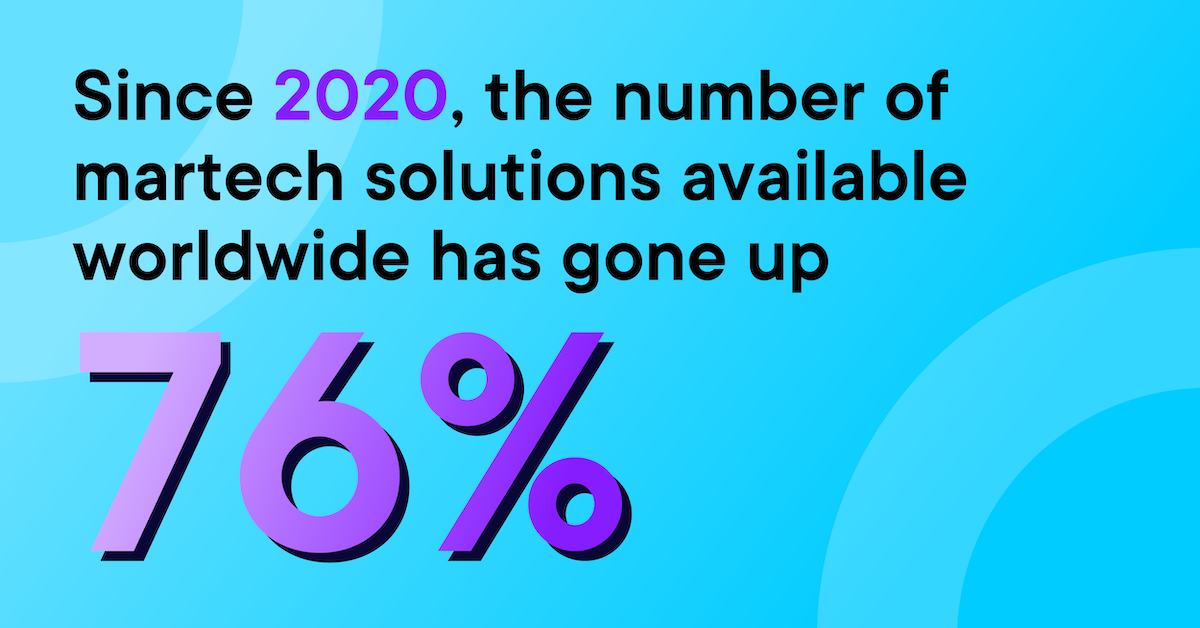How to build an integrated marketing tech stack (AKA. the best kinda martech stack)
Let’s be real, choosing which software and apps to incorporate into your stack isn’t anyone’s favorite hobby.
It takes time, patience, and – most of the time – quite a bit of trial and error.
Why? Because there are lot of them out there:

For a successful and streamlined marketing strategy, you want to have an integrated marketing tech stack, which probably means a technology audit and reevaluation is probably coming your way.
But fear not, we’re about to tell how to build a martech stack that *actually* works.
What is a martech stack?
A marketing technology (martech) stack is a collection of software tools used to optimize or automate specific marketing tasks, from project management to SEO to lead generation.
How to build an integrated marketing tech stack
Okay, let’s go with a step-by-step on how to build an integrated marketing tech stack:
-
Identify your primary marketing strategies and goals
What are your marketing goals, and how are you looking to achieve them?
By identifying your priorities as a team or department, you can establish the type of tools that will (or should) help you get there.
Think about the big rock, pebble, sand analogy for prioritization. Before you’re there like “Say WHAT?”, here’s how it goes:
You’ve got a jar. You’ve got big rocks, pebbles and sand to fill it. Start with the sand and the pebbles, and you won’t have room for the big rocks. And those big rocks? They’re your big priorities.

The moral of the story: don’t take up too much space with the lower priorities – whether that’s tasks that people throw at you in the office or over message. Stay on track by focusing on those big rocks.
Here’s are a few examples:
Goal
Marketing Strategy
Tools
Increase organic traffic
Content creation and SEO
Content management software (CMS) product, a content distribution tool, an SEO tool, content marketing software, etc.
Get more website visitors to convert
Redesign the website
Conversion optimization tool, an email marketing product, etc.
Improve customer communication
Automate transactional emails
Marketing automation software, email marketing software, etc.
-
Look at what you’ve got already
This step requires you to map your current tech stacks across silos and teams. Go one step further by surveying those that use it to understand how often they use each tool or app, and what they believe could be improved.
Ask each team questions like:
- How are you finding this tool?
- How much time are you spending on it?
- Do you use all its capabilities?
- Have you heard any recommendations for other tools?
- Any free trials going? 👀
-
Get stakeholders involved
There are certain things that stakeholders want to see – for example, marketing analytics and reporting. Take their ahem... ✨ rational and realistic ✨ requests or asks into account.
This may highlight where certain tools are falling short, and inspire you to look into tools you’d not considered yet.
-
Bucket your list into different categories
Now it’s time to fully assess your options.
Think: what's working, what’s not, what needs changing or updating, and what needs adding or deleting?
The easiest way to do this is to consider the different martech categories that you need as a business, before fitting your list into those buckets.
If you’re asking yourself “Where do I even start on martech categories?”, we’re way ahead of you.
Most common categories in a martech stack
To make sure your marketing team is aligned as possible – both in what they’re all working on and what they’re working towards – you need tools that encourage visibility, collaboration, communication, and ease of use.
Here are the most common categories in a marketing technology stack:
- SEO and keyword research: Semrush, Ahrefs
- Content intelligence: Clearscope, Chartbeat
- Social media management: Hootsuite, Buffer
- Marketing analytics and reporting: Google Analytics, Coremetrics
- Multichannel marketing management: Optimizely Content Marketing Platform, Pardot
- CRM systems: Salesforce, Microsoft Dynamics
- Sales enablement: Highspot, Brainshark
Frankenstack vs an all-in-one platform?
But hold up, here’s the thing: too many tools can result in distraction and... if we’re being honest with ourselves, money wasted.
Here are marketing tech stack statistics you *might* find interesting:
- Marketers are only using one third of their stack’s capability
- 64% believe their martech stacks have become more complex in recent years
- 55% of surveyed marketers are looking to simplify their stack within the next year
So, if building a martech stack seems daunting to you, that’s because it absolutely is.
The power of an almighty, all-in-one content marketing platform
With all those scary stats, technology burnout, and a general sense of I-can't-be-bothered-to-learn-how-to-use-this-new-tool, it’s no surprise that content marketing platforms are quickly becoming every marketer’s bestie.
Why? Because CMPs do all the heavy lifting for you. That means:
- No integration frustration (cue: smug grins from your engineers)
- Clarity and visibility from content ideation through to creation
- Single source of truth for analytics and reporting
Having all your marketing campaigns and assets in one searchable place means everyone can be on the same wavelength. Being aware of what work is going on within your team is a key step in a killer integrated marketing strategy.
More on that, here: Your guide to a building a bigger, badder, more integrated marketing team.
Anyway, when a CMP is up against a confusing, headache-inducing, multiple-tab-guaranteed option – it's an easy win.
Optimizely Content Marketing Platform provides marketing teams – anywhere and everywhere – with the content hub and tools they need, all in one place.
- Last modified: 4/28/2025 2:51:01 PM

